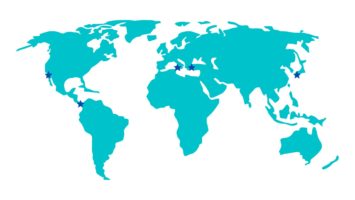
The Blue Zones
The Blue Zones are clusters of the world with an abnormally high population of people older than 100. In these regions, many people who live past 100 have remarkably good health and few chronic or debilitating diseases. In this article, we will discuss these areas of the world and their diet and lifestyle factors.
What are the Blue Zones?
The Blue Zones are six areas of the world where people have longer than average lifespans. These regions are home to unusually large numbers of people who live past age 100. In fact, the rate of people who live past age 100 is roughly ten times higher in these areas than the average in the United States.
The “Blue Zone” areas include Okinawa, Japan; Nicoya, Costa Rica; Loma Linda, California; Sardinia, Italy; and Icaria, Greece.
Blue Zones Map
You can find a map of these communities here.
What makes an area a Blue Zone?
Blue Zones are areas of the world with a relatively high percentage of people that live to 100 or older. These people also seem to have relatively good health and a low incidence of chronic disease.
Blue Zones Diet
Researchers found that people who live in these regions share many dietary patterns.
They eat a plant based diet. Most people in these areas choose to eat fish about five to ten times per month and mostly eat fruits, vegetables, legumes and nuts. They also rarely eat red meat.
People who live in these regions don’t usually eat till they are totally full. Instead, they eat slowly and stop eating when they are about 80 percent full.
Additionally, people in the Blue Zones drink in moderation. Most people in these communities drink a glass of red wine several times per week.
What do the Blue Zones Have in Common?
People with long lifespans who live in these communities all share a lot of lifestyle traits.
People in these regions work for most of their life, even if they stop performing paid work. However, they aim to approach their work with a sense of personal purpose and service.
Many people living in the Blue Zones often have some type of religious beliefs.
In addition, most people who live in these regions get a lot of lifestyle activity and physical activity related to their jobs. For instance, older male farmers in one area perform a lot of physical activity walking and climbing stairs per day in addition to herding sheep. People in these regions rarely go to a gym to perform exercise. However, they incorporate exercise into their daily lives.
People in the Blue Zones often live in multi-generational homes. Grandparents often help take care of their grandkids.
Finally, people in these regions rarely have a youth obsessed culture. In contrast, they often feel that getting older is a positive thing and have respect for their elders.
Most people living in these areas perform some sort of work for most of their lives. However, they might not hold the same attitudes about work as people in North American culture.
Finally, most people who live in a Blue Zones community don’t have rigid schedules about sleeping or waking and don’t set an alarm. This reduced time pressure might also carry over to their work lives as well.
What can the Blue Zones Teach Us?
The Blue Zones suggest that our habits, lifestyle and beliefs can influence our lifespan and capacity well into old age.
For instance, eating a primarily plant based diet is associated with a lower risk of many different types of cancer, heart disease and coronary artery disease.
Additionally, staying active throughout the day can boost health, reduce the risk of heart disease, cancer, heart attacks and strokes even better than just exercising for one hour per day. The people in the Blue Zones keep active throughout the day and rarely have sedentary jobs.
Notably, people with some sort of religious beliefs, sense of personal purpose and positive association with aging tend to age better and have better health in older age. Holding religious beliefs is even associated with a longer lifespan.
Finally, the people in the Blue Zones hold lifestyle habits that influence life quality as much as lifespan. For instance, a reduced sense of time pressure and materialism can increase quality of life. Living with extended family members can improve relationships and take the strain off of parents as grandparents help with child care.
Closing Thoughts
While we may not have total control over our lifespan, we can learn from people who live in the Blue Zones.
Cultivating a greater sense of community and social support, engaging in physical activity, eating a plant based diet and embracing a sense of life purpose may help us to live longer and to age better.
What are your thoughts? Do you adopt any Blue Zones habits? Please let me know in the comment section below.